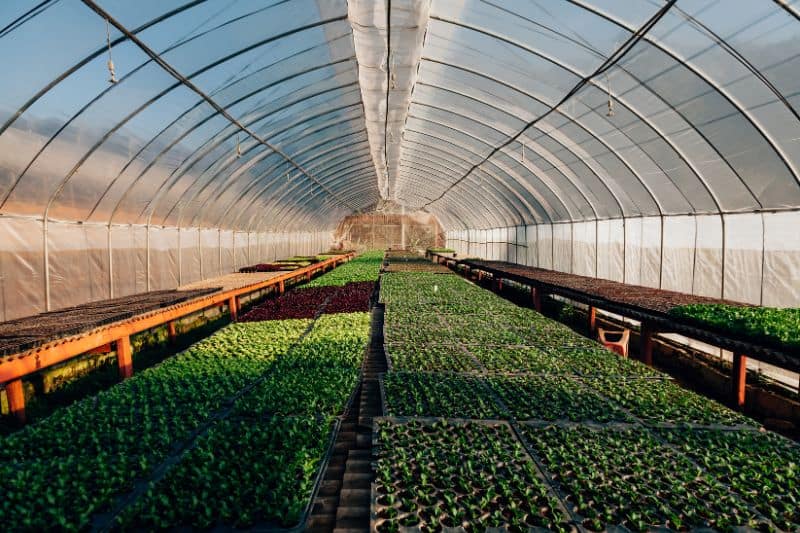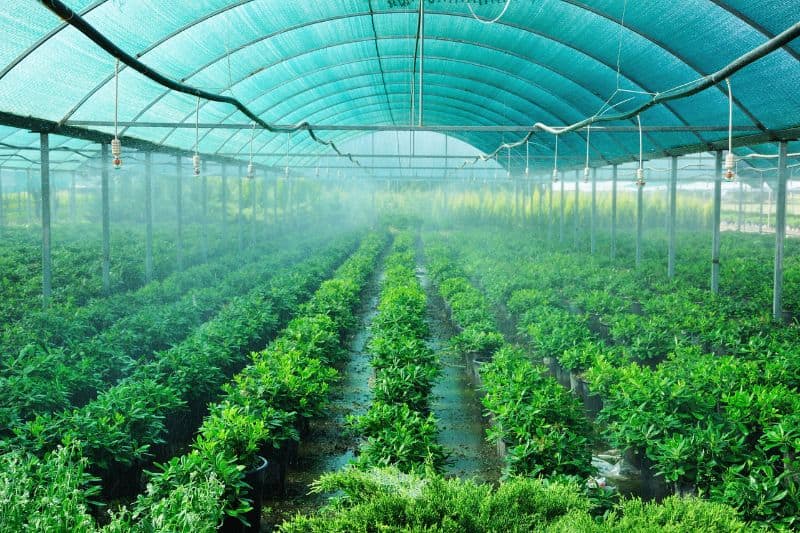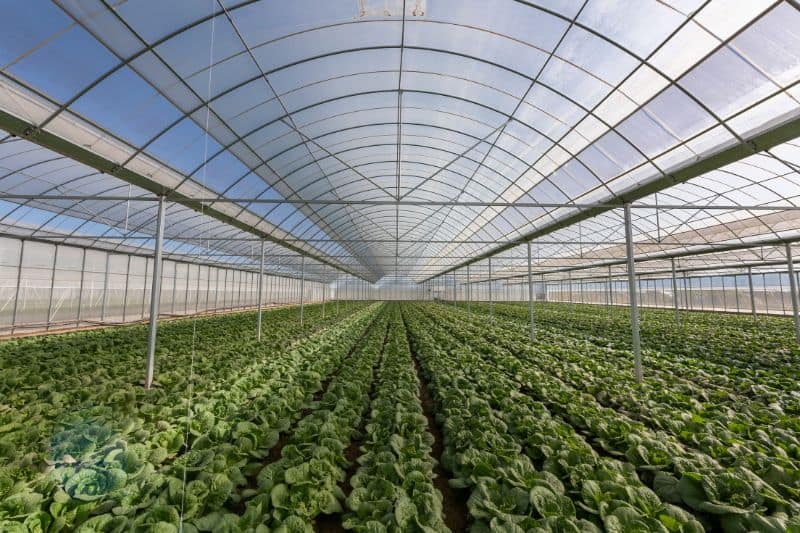Greenhouses have become increasingly popular to grow plants and produce in a controlled environment. As you explore the world of horticulture, you might wonder if these seemingly beneficial structures negatively affect the environment.
You may know that greenhouses allow year-round cultivation by maintaining optimal temperature and humidity levels. However, there are also concerns about excessive energy usage, water consumption, and the potential release of harmful gases. In this article, we will delve into the environmental impacts of greenhouses and weigh the pros and cons.
Understanding the complexities of greenhouses and their impact on the environment is crucial for you to make informed decisions about their usage. Whether you’re an avid gardener, a concerned citizen, or simply curious, join us as we examine this fascinating topic.
Understanding Greenhouses
What is a Greenhouse?
A greenhouse is a structure, often made of glass or clear plastic, used to grow plants in a controlled environment. By keeping a consistent temperature and humidity inside, you can cultivate various plants all year long, even if they are not native to your region. Greenhouses can be found in many forms, from small, backyard structures to large, commercial facilities.
How Do Greenhouses Work?
Greenhouses work by trapping sunlight and converting it into heat. When sunlight enters the greenhouse through its transparent walls and roof, it warms the air, soil, and plants.
This warm air is retained within the enclosure, creating a stable environment. To maintain this optimal environment, you can add ventilation for air circulation and use heating or cooling systems when necessary.
In a greenhouse, you control the factors affecting plant growth, such as:
- Temperature: The enclosed space maintains a consistent temperature, protecting your plants from harsh outdoor weather conditions. You can adjust the temperature with heaters or cooling systems as needed.
- Humidity: Managing humidity levels is crucial for preventing mold and diseases in your plants. Ventilation systems can help regulate moisture levels.
- Light: Greenhouses receive natural sunlight through their transparent walls and roofs, which are essential for photosynthesis. You can also install supplemental lighting when needed or for specific plant requirements.
Greenhouses provide benefits such as year-round growing opportunities, protection from weather fluctuations, and the ability to cultivate a diverse range of plants.
However, it is essential to consider the environmental impacts, such as resource consumption and the use of synthetic fertilizers or pesticides, when weighing the pros and cons of using greenhouses.

Are Greenhouses Bad for the Environment?
Greenhouses can benefit the environment by providing an ideal growing environment for plants throughout the year. However, there are a few factors to consider when evaluating their environmental impact.
Energy consumption: Greenhouses require heating and cooling systems to maintain the optimal temperature for plant growth. These systems often rely on fossil fuels, contributing to greenhouse gas emissions and climate change. You might consider using renewable energy sources such as solar or geothermal power to reduce the environmental impact.
Water usage: Greenhouses can use significant water to irrigate plants. However, many modern greenhouses incorporate water-saving technologies, like drip irrigation and recirculation systems, to help conserve water. Using these technologies, your greenhouse can contribute to a more sustainable use of water resources.
Materials: The materials used to construct a greenhouse, like plastic and glass, might have an environmental impact during their production and disposal. You might want to choose eco-friendly materials, such as reclaimed wood and recycled glass, to lessen the environmental footprint of your greenhouse.
Pesticide usage: In greenhouses, the controlled environment might result in fewer pests and diseases compared to crops grown outdoors. However, some greenhouses still rely heavily on chemical pesticides, which can have negative effects on the environment and human health. You could consider using organic or integrated pest management approaches to minimize pesticide usage and protect the environment.
By reducing energy consumption, water usage, and choosing sustainable materials and pest management practices, you can lessen the negative effects and create a more environmentally friendly greenhouse.
Sources of Greenhouse Gases
Greenhouse gases are emitted from many different sources, including transportation, agriculture, electricity production, industry, commercial & residential, and land use & forestry. However, these sources will be discussed more in this section.
1. Transportation
Transportation is the largest source of greenhouse gas emissions in the United States, accounting for 30% of all emissions. Transportation sources include cars, trucks, buses, trains, planes, and boats.
Energy used to power vehicles includes gasoline and diesel fuel and electricity from coal-fired power plants and wind turbines.
2. Agriculture
Agriculture is also the most significant source of greenhouse gas emissions in the United States.
This sector accounts for approximately 11 percent of U.S. GHG emissions, with more than half coming from livestock production (including enteric fermentation and manure management). The remainder comes from crop production, including cultivation and agricultural soil management.
3. Electricity Production
Electricity production is a significant source of greenhouse gases. The electricity sector is responsible for 25% of all global emissions, meaning it is the second largest emitter behind the industry.
Even though fossil fuel energy is decreasing, coal still accounts for more than half of electricity production worldwide.
Although natural gas is becoming a more popular source of electricity generation, it still has a long way to go before it can compete with other forms of energy generation, such as wind power or solar photovoltaic cells.
4. Industry
The industrial sector is one of the largest sources of greenhouse gases. The majority of these emissions come from the burning of fossil fuels. Fossil fuels, such as coal, oil, and natural gas, generate electricity and heat homes.
5. Commercial & Residential
Greenhouse gas emissions from businesses and homes are primarily caused by using fossil fuels for heating.
Fossil fuels include coal, oil, and natural gas. Burning these fuels releases carbon dioxide (CO2) into the atmosphere. Although CO2 is a natural part of our atmosphere, too much can cause global warming and climate change.
6. Land Use & Forestry
Land use and forestry provide us with several benefits. Forests sequester carbon released from CO2 when burned or cut down. When forests are managed properly, the carbon stored in trees can be used to generate energy or as a building material.
Forests also provide habitat for wildlife and help regulate water cycles. Deforestation can cause changes in climate and erosion as well as soil depletion.
Positive Impact of Greenhouses
Fostering Plant Growth
Greenhouses create a controlled environment where you can grow various plants year-round. Your plants can thrive and produce better yields by maintaining the right temperature, humidity levels, and light conditions.
This is especially beneficial for delicate plants that would otherwise be unable to withstand harsh outdoor conditions. In a greenhouse, you give your plants optimal growing conditions, leading to healthier, more productive plants.
Seasonal Independence
One of the most significant advantages of greenhouses is their ability to defy seasonal constraints. With a greenhouse, you can grow your favorite plants and vegetables even when the weather outside is not optimal for their growth.
This means you can continuously supply fresh, homegrown produce without relying on seasonal availability. It also allows you to experiment with exotic plants that may not be native to your area, broadening your gardening horizons.
Pest Control
Dealing with pests can be challenging, but greenhouses solve this problem. You reduce the risk of pest infestations by isolating your plants from the outside environment.
Not only does this protect your plants from damage, but it also decreases the need for harmful pesticides. Additionally, a greenhouse gives you more control over which insects can access your plants, enabling you to introduce beneficial insects that help keep the pests at bay.
Using greenhouses for pest control ultimately leads to healthier plants and a safer growing environment.
Do Greenhouses Produce Greenhouse Gasses?
Greenhouses are designed to create a controlled environment for plants to grow, but the question is whether they contribute to greenhouse gas emissions. Let’s delve into this topic and explore the factors involved.
Firstly, it is essential to differentiate between the greenhouse effect and the gases emitted from greenhouses. The greenhouse effect is a natural process whereby gases like carbon dioxide, methane, and water vapor trap heat in the Earth’s atmosphere, keeping the planet warm.
On the other hand, greenhouses provide a controlled environment for cultivating plants outside their native climates.
The energy sources used in greenhouses need heat to maintain optimal growing conditions, especially in colder climates. Burning fossil fuels, such as natural gas, oil, or coal, can supply this heat. These sources release carbon dioxide when burned, contributing to greenhouse gas emissions.
However, some greenhouses are adopting more sustainable heating options like biomass, solar, or geothermal energy. These options produce fewer emissions, making them environmentally friendly options for greenhouses.
Another point to consider is the materials used in constructing greenhouses. These structures often use plastic, glass, or polycarbonate as a primary material, which has its manufacturing process contributing to greenhouse gas emissions.
However, this is a one-time emission during the production phase, and a well-maintained greenhouse can last for many years, reducing its overall impact.
It is crucial to recognize that greenhouses are essential in food production. By providing a controlled growing environment, they can produce food all year round and reduce the need for transportation emissions. This is especially important for food items that are typically shipped in from other countries, where they are grown under optimal conditions.
While greenhouses do have some impact on greenhouse gas emissions, the level of impact greatly depends on the energy sources used and the materials chosen.
By opting for sustainable energy sources and building materials, you can enjoy the benefits of a greenhouse while minimizing its potential negative effects on the environment.
Potential Harmful Effects of Greenhouses
Energy Consumption
Greenhouses can consume a considerable amount of energy, especially during colder months. You must maintain an ideal temperature inside the greenhouse, which may require artificial heating systems.
These heaters often run on electricity or natural gas, contributing to your overall energy consumption. Implementing proper insulation and energy-efficient heating options can help minimize the ecological fingerprint.
Water Usage
Your greenhouse plants will likely require large amounts of water through irrigation systems or manual watering methods.
This water consumption can contribute to water shortages and stress local water resources. You can mitigate this impact by using water-efficient irrigation systems, collecting rainwater, and selecting drought-tolerant plant varieties.
CO2 Emissions
Greenhouses generally contribute to CO2 emissions since they rely on energy produced mainly by burning fossil fuels. Moreover, the need for CO2 to grow plants more rapidly within a greenhouse may lead to direct CO2 emissions, as it can be artificially pumped into the atmosphere.
Invest in sustainable energy sources such as solar panels or wind turbines to lower your greenhouse’s carbon footprint and consider more environmentally friendly CO2 sources and levels.

Greenhouse Gases and Greenhouses: What’s the Difference?
To understand the environmental impact of greenhouses, you need to know the difference between greenhouse gases and greenhouses.
Greenhouse gases trap heat in the atmosphere, resulting in the greenhouse effect. The primary greenhouse gases are carbon dioxide (CO2), methane (CH4), and nitrous oxide (N2O). These gases are released from various sources such as burning fossil fuels, deforestation, and agriculture.
On the other hand, a greenhouse is a structure made of transparent materials like glass or plastic. It provides a controlled environment for plant growth by regulating temperature, humidity, and light conditions. Greenhouses are often used to grow crops, especially in cooler seasons or climates.
Now that you know the distinction between the two, you might wonder how greenhouses could harm the environment.
Since greenhouses are designed to regulate temperature, they require energy for heating and cooling. This energy consumption could increase greenhouse gas emissions if the energy source is non-renewable, such as coal, oil, or natural gas.
Additionally, greenhouses can also have an impact on water usage. Growing plants inside a greenhouse might require significant amounts of water, especially in arid or drought-prone areas. Using water-efficient irrigation methods and practices is crucial to minimize water wastage in greenhouse cultivation.
How to Create a Low-Emission Greenhouse?
Creating a low-emission greenhouse is crucial to minimize the environmental impact of greenhouse growth. Here are some steps you can take to make your greenhouse more sustainable:
1. Choose the right materials: Opt for durable and energy-efficient materials for your greenhouse structure. For example, use double-glazed or polycarbonate panels instead of single-pane glass to improve insulation and reduce heat loss.
2. Optimize ventilation: Proper ventilation helps regulate temperature and humidity in your greenhouse, reducing the need for artificial heating and cooling. Use vents, fans, and thermal screens to maintain optimal growing conditions.
3. Utilize natural light: Maximize sunlight exposure by positioning your greenhouse in a spot that receives ample sunlight throughout the day. This will reduce your reliance on supplemental lighting and save energy.
4. Install energy-efficient lighting: When supplemental lighting is necessary, opt for energy-saving LED grow lights, which consume less electricity and produce less heat than traditional high-pressure sodium lamps.
5. Implement water-saving techniques: Collect rainwater for irrigation and use drip irrigation systems or automated watering systems to minimize water waste. This conserves water and helps prevent the growth of algae and mold.
6. Opt for green energy sources: Consider investing in solar panels, wind turbines, or other renewable energy sources to power your greenhouse. Doing so can reduce your dependence on fossil fuels and lower your greenhouse gas emissions.
By incorporating these practices into your greenhouse design, you can create a more environmentally friendly growing space for your plants while reducing your overall carbon footprint.
Sustainable Greenhouse Practices
Energy Efficiency
By implementing energy-efficient technologies, you can reduce the environmental impact of your greenhouse. Consider using high-quality glazing materials and insulation to optimize heat and light in your greenhouse.
Double- or triple-layered polycarbonate sheets help retain heat while allowing ample light inside. You can also install energy curtains to limit heat loss at night and reduce the need for artificial lighting.
Moreover, utilizing energy-efficient heating and cooling systems, such as heat pumps, can reduce your greenhouse’s energy consumption.
Water Conservation
Water is a precious resource, and conserving it should be a priority for every greenhouse owner. Utilize drip irrigation systems that effectively distribute water to your plants, minimizing water waste.
Another method is capturing and recycling rainwater for irrigation purposes. You can apply mulch or other ground covers around your plants to reduce evaporation.
Finally, consider choosing native plants that are well-adapted to your region’s climate and require less water.
Responsible Waste Management
Effectively managing waste is crucial for maintaining a sustainable greenhouse. Begin by reducing the use of single-use plastic products such as pots, trays, and markers. Opt for reusable or biodegradable alternatives instead.
To reduce plant waste, practice regular pruning and responsible plant disposal, and consider composting any organic waste.
Also, properly dispose of hazardous chemicals according to local regulations to prevent soil and water contamination. By following responsible waste management practices, you contribute positively to the environment and maintain a sustainable greenhouse.






